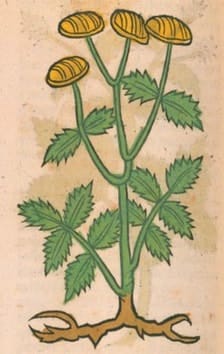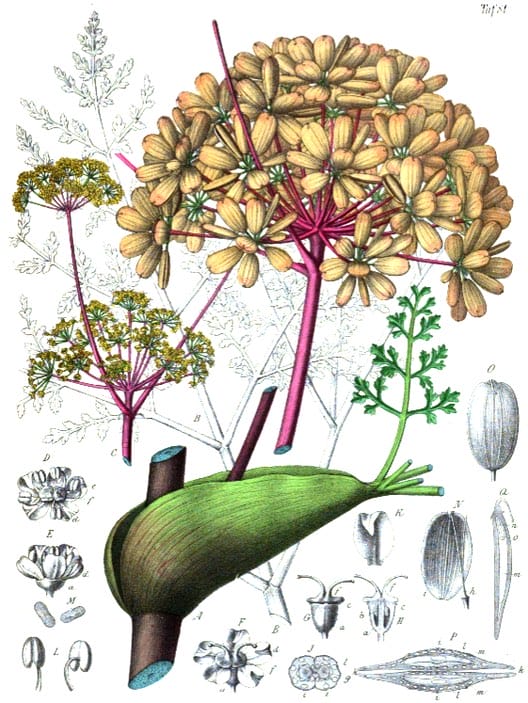Galbanum‘Syrian Ferula’, Fennel Giant, MetopiumJaosheer (Unani) |

|
 Ortus Sanitatis, Meydenbach, 1491
Ortus Sanitatis, Meydenbach, 1491 Atlas der officinellen pflanzen (2), Felix, 1899
Atlas der officinellen pflanzen (2), Felix, 1899 Members CLICK HERE for the PRO VERSION
Members CLICK HERE for the PRO VERSIONBotanical name:
Ferula galbaniflua (syn. F. rubricaulis, Bubon galbanum)
Parts used:
Gum
Temperature & Taste:
Warm, dry. Pungent, Bitter, aromatic
Classifications:
2B ATTENUATERS. 2K. RESOLVENT. 2L. EMOLLIENT. 2M. DRAWING. 2Q. ANODYNE
3G. EMMENAGOGUE
4f. SPLENETIC. 4k. ARTHRITIC
Uses:
1. Moves Blood and Qi, Promotes Menstruation:
-Amenorrhea, Dysmenorrhea
2. Clears Cold-Phlegm, Stops Cough:
-Coughs, Wheezing
3. Clears Damp, Warms the Stomach:
-Poor digestion from Cold or Damp
4. Clears Wind-Damp, Stops Spasms:
-Dizziness, Vertigo
5. Resists Poison
-Fevers and Intermittent Fever
6. Externally:
-applied to Sciatica and Nodes of the Joints (Pliny)
Dose:
… available in PRO version
Substitute:
… available in PRO version

Main Combinations:
1. Cough from Cold:
i. Galbanum with … available in PRO version
ii. violent Cough, Galbanum, … available in PRO version
iii. Galbanum with … available in PRO version
iv. Galbanum with … available in PRO version
2. Hoarseness of the Throat, Galbanum, … available in PRO version
3. Cold Phlegm obstructing the Lungs:
i. Galbanum with … available in PRO version
4. Phthisis, and for coughing up Blood and Pus, Galbanum, … available in PRO version
5. Pleurisy, pain in the Lungs, coughing of Pus and Blood, Galbanum, … available in PRO version
6. Lung Ulcers, melt Galbanum and … available in PRO version
7. To increase weight in the thin, take Galbanum with … available in PRO version
8. Amenorrhea:
i. Galbanum with … available in PRO version
ii. Galbanum with … available in PRO version
9. To promote Birth, Galbanum with … available in PRO version
10. To expel a dead fetus, Galbanum and … available in PRO version
11. Against Poison, Galbanum with … available in PRO version
12. Internal Abscess, Galbanum … available in PRO version
13. Chronic Liver Hardness, Galbanum … available in PRO version
14. Head Ulcers, Galbanum with … available in PRO version
15. Rodent Ulcers, Galbanum with … available in PRO version
16. Suppuration of the Ears, Galbanum with … available in PRO version
17. Ear ache and poor hearing, Galbanum … available in PRO version
Major Formulas:
Pills Proven for Coughs (Galen)
Expert Pills for Cough
Antidote Appropriate for Cough
Antidote Proven for Diverse Diseases (Nicholas)
Electuarium Acharistum (Nicholas)
Cautions:
1. Not used during Pregnancy
2. ‘It is thought to cause difficult Micturation’ (Dioscorides); Strangury (Pliny)
3. Avicenna noted it is not good for the Nerves unless affected by Damp.
Main Preparations used:
Purified Galbanum (dissolved in liquor, strained and dehydrated), Distilled Oil
-
Extra Info
-
History
|
‘We have already given some description of galbanum: to be good, it should be neither too moist nor too dry, but just in the state which we have mentioned. It is taken by itself for inveterate coughs, asthma, ruptures, and convulsions; and it is employed externally for sciatica, pains in the sides, inflamed tumours, boils, denudations of the bones, scrofulous sores, nodes upon the joints, and tooth-ache. It is applied with honey also, to ulcerations of the head. In combination with oil of roses or with nard, it is used as an injection for suppurations of the ears; and the odour of it is useful for epilepsy, hysterical suffocations, and faintness at the stomach. Employed as a pessary or as a fumigation, it brings away the foetus in cases of miscarriage; branches too of hellebore covered with it and laid beneath the patient, have a similar effect. |
‘We have already stated that serpents are driven away by the fumes of burnt galbanum, and they will equally avoid persons whose body has been rubbed with it. It is curative also of the sting of the scorpion. In protracted deliveries, a piece of galbanum the size of a bean is given in one cyathus of wine: it has the effect also of reducing the uterus when displaced, and, taken with myrrh and wine, it brings away the dead foetus. In combination with myrrh and wine too, it neutralizes pqisons—those which come under the denomination of “toxica” in particular. The very touch of it, mixed with oil and spondylium, is sufficient to kill a serpent. It is generally thought to be productive of strangury.’ (The Natural History of Pliny, trans. by Bostock and Riley, Vol. 5, 1856) |
